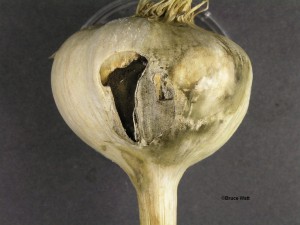Skin blotch of garlic caused by the fungus, Embellisia allii, has been found in a homeowner’s garden. Symptoms on infected plants include the a diffuse coating of charcoal-colored flecks on the outer surfaces of infected stems.

Skin blotch of garlic caused by Embellisia allii. (Photo by Bruce Watt, University of Maine)
Although skin blotch causes mostly cosmetic injury (the outer leaf sheaths can be removed) it can cause bulb cankers. Skin blotch is a soil-borne pathogen that can survive from season to season on infect plant debris left in the field. High humidity, moist soils and heavy manure applications may also favor disease development. According to the literature white skinned cultivars tend to be more susceptible than red skinned cultivars. Once skin blotch is detected in the field, it is important that growers their rotate garlic and onion crops away from the infested area for as long as possible. Proper drying conditions and storage keeping relative humidity less than 70% will reduce the potential for skin blotch. Sorting and removal of diseased bulbs is highly recommended. When the disease is present, removing the affected outer scales on garlic bulbs before sale or use is usually sufficient.Organic growers should carefully examine seed from bulbs before planting, remove the outer infected leaves and try to only plant from disease-free material. Growers should also maintain a plant spacing and location that allows for increased air movement and direct sunlight. Commercially, fungicides used for controlling other leaf blights (Botrytis and Purple Blotch) should help control Skin blotch.

